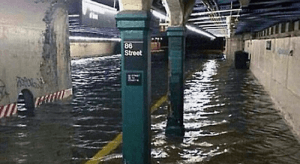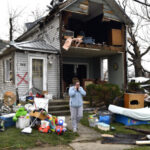The warming Atlantic Ocean has raised the risk of another Hurricane Sandy. And still, trillions of dollars of real estate and infrastructure near the shores of New York City and northern New Jersey remain vulnerable to devastation.
A storm-surge barrier similar to those in Louisiana and parts of Europe might protect the area, but politicians have questioned its $30 billion cost, effectiveness and environmental impact. A group of scientists, planners and property owners is urging the U.S. Army Corps of Engineers to accelerate its study of the project. It may take another hurricane to speed up the process.
“The danger is increasing as the sea level rises,” said Malcolm Bowman, an oceanographer at the State University of New York at Stony Brook, who is among the group. “It won’t take a monster storm like Sandy to devastate the region.”

Bowman warned of a catastrophic storm as far back as 2005, in a New York Times Op-Ed article. Seven years later, Sandy struck the region, flooding airports and tunnels and ravaging shore communities from Atlantic City, New Jersey, to Bridgeport, Connecticut. It caused $68.9 billion in damage, making it the second-costliest storm in U.S. history after Katrina, according to the National Oceanic and Atmospheric Administration.
Water Wars
Bowman’s group is pushing for an evaluation of a 5-mile (8-kilometer) retractable storm-surge barrier at the mouth of New York Harbor from the Rockaways to New Jersey’s Sandy Hook. That, and another smaller structure at the western edge of Long Island Sound, could protect about 800 miles of shoreline from Port Elizabeth, New Jersey, to the Bronx, Bowman says.
As Bowman describes it, before a major storm, barriers would rise from the seabed or close in a gate-like structure to deflect the force of a wind-blown surge, as occurred with Sandy.
“You have to allow for marine traffic and the daily flow of the tides to flush out the harbor,” Bowman said, “But when a storm is forecast with enough wind at high tide to create a surge, you close the gates or raise it from the seabed so water that wants to flow into the harbor can’t.”
Studying Studies
Weeks after Sandy, New York Governor Andrew Cuomo said his administration planned to talk with city and federal officials about the possibility of installing storm-surge barriers. Corps engineers, in discussions with New York and New Jersey since last August, are still studying what protection strategies merit further study.
“At this point, it is premature to say whether broad-scale solutions such as that advocated by this group, or other more regional or localized potential solutions will fare best,” said Corps spokesman Hector Mosley.
Piecemeal Jobs
In the meantime, the state has moved ahead with a $616 million plan for Staten Island that includes a boardwalk promenade that would double as a storm-surge bulwark. The Corps has that project scheduled for completion in 2022, paid mostly by the federal government.
Billions more in federal, state and city funds are being spent along shore areas, enhancing dunes and berms on beaches, cultivating wetlands, building walls and awarding subsidies for waterproofing homes and office buildings. City officials also envision a mostly-U.S. funded $816 million horseshoe-shaped elevated park wrapped along the southern half of Manhattan, dubbed “The Big U,” to keep out the Hudson and East Rivers.
Such localized approaches may work as well or better than a mega-project, said Jainey Bavishi, Mayor Bill de Blasio’s director of the Office of Recovery and Resiliency. Her concerns about a storm barrier include cost and construction time; possible environmental impact; and whether it would leave densely populated areas of Long Island and New Jersey vulnerable, and perhaps even more exposed to flooding from displaced water.
“A harbor barrier is not the silver bullet,” Bavishi said.
Sea Life
Many of these issues have been solved with barriers that protect low-lying populations around the world, said Robert Yaro, former president of New York’s Regional Plan Association. Its retractable feature would allow for marine traffic and tidal flow, minimizing impact to sea life and water quality, he said. The technology holds the promise of protecting the region for catastrophic floods for the next 150 years, Yaro said.
“The Dutch have used this engineering for decades and barriers currently protect New Orleans, Stamford, Providence, London and St. Petersburg, Russia,” Yaro said. “We in New York are far behind and among the cities on Earth we have the most to lose.”
Yaro and Bowman were among several advocates promoting the idea last month at an all-day conference in lower Manhattan attended by 250 municipal bond investors, real estate developers, business owners, insurance companies, and planners.
Lessons Learned
They heard Andrew Kopplin, former director of the Louisiana Recovery Authority, describe how in New Orleans after Katrina, a bipartisan coalition of elected officials and business leaders persuaded Congress to approve a $14.5 billion system of levees and a storm-surge barrier. The barrier, a 1.8-mile array of gates, protected the city from Hurricane Isaac’s landfall in 2012, said Kopplin, now president and chief executive officer of the Greater New Orleans Foundation, a non-profit charitable civic group.
“It was simply a matter of political will,” he said.
Officials in the Cuomo and de Blasio administrations say they await the Corps’ findings.
“We clearly want to see the New York Harbor barrier studied,” said James Tierney, Cuomo’s deputy environmental commissioner for water resources. “The process requires a full-blown feasibility study. The Army Corps process is what we have to live with.”
Next Storm
Marco Pasanella, 54, who lives above his gourmet wine shop on lower Manhattan’s South Street that got flooded when Sandy hit, says the pace and scope of government response has been disappointing.
He’s says he’s seen no measures that would protect his neighborhood if another storm hit. The National Oceanic and Atmospheric Administration has predicted as many as 17 tropical storms, about five more than average, may hit the Atlantic coast this year.
“The decisions have Balkanized the neighborhoods with a piecemeal approach, just a series of uneven, irregular blockades that will not stop the water from finding its way ashore,” Pasanella said.
Across Manhattan at Chelsea Piers, a recreational facility situated over the Hudson, Michael Braito, the property’s chief engineer, said neighborhood protections won’t be enough to stop storm-surge water coursing through his building.
“These piecemeal fixes buy little more than peace of mind,” Braito said. “It’s like a boat with 100 holes and we’ve patched half of them and we’re going to sink. They need to think bigger.”
Was this article valuable?
Here are more articles you may enjoy.

 SC High Court Strikes ‘Troubling’ Denial of Comp Claim, Says Can’t Be Based on Stats
SC High Court Strikes ‘Troubling’ Denial of Comp Claim, Says Can’t Be Based on Stats  CoreLogic Report Probes Evolving Severe Convective Storm Risk Landscape
CoreLogic Report Probes Evolving Severe Convective Storm Risk Landscape  Supplemental Claims Don’t Need to Include Damage Estimates, Fed Appeals Court Says
Supplemental Claims Don’t Need to Include Damage Estimates, Fed Appeals Court Says  Gallagher: Global Insured Natural Disaster Claims Again Dominated by Severe U.S. Storms
Gallagher: Global Insured Natural Disaster Claims Again Dominated by Severe U.S. Storms 